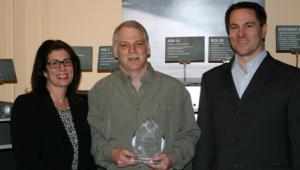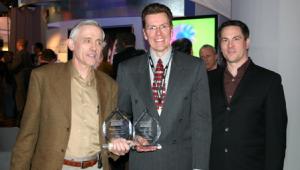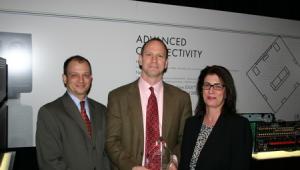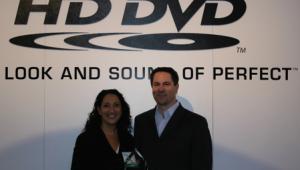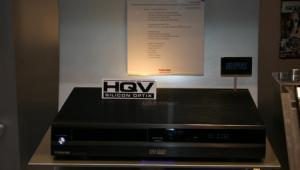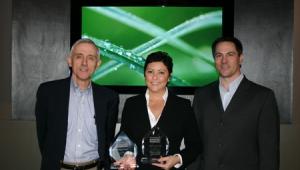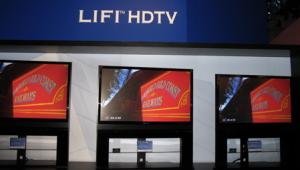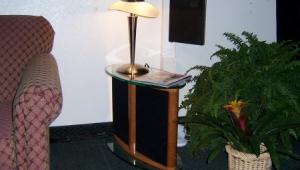Onced Upon a CES

The Blu-ray camp acted as if the format war was over. They may have a point. The only major studio not releasing on Blu-ray is Universal, and that is apparently because of corporate agreements that could end at any time. And announcements of new titles were far more plentiful on the Blu-ray side.
HD DVD still has some powerful supporters, however, and their announcement of new players to come this year from sources other than Toshiba is important. One hardware supplier does not a successful format make.
But the launch of a player compatible with both HD DVD and Blu-ray was probably the most talked about story of the show. While LG's Super Multi Blue player does have some shortcomings in how it handles the features on HD DVD (shortcomings that may be fixable in firmware), it's the sort of solution that many early adopters have been waiting for. While delivery of this $1199 product has been promised for next month, no one at the press conference bothered to ask if production players were on the boat. They had better at least be on the way to the docks in South Korea if we expect to see them in stores here in a month. I suspect that the February delivery date is at least a month too optimistic.
If one solution to the format war is good, why not two? And with the introduction of its Total HD, dual-HD format disc, Warner Brothers delivered. Well, sort of. We won't see such discs, which will carry the HD DVD version of the program on one side and the Blu-ray version on the other, until late 2007, and who can predict the battle lines by that time? The announcement that the discs will be two-sided/two layers per side, with each format provided with its full current bit capability (50GB for Blu-ray, 30GB for HD DVD) was gratifying, but can they deliver on that promise? Any compromise in the available data space for each format would be unacceptable. It also remains to be seen exactly how much the studios will charge for these Total HD discs. I consider the current $40 suggested list price of Warner's current Combo discs (HD DVD on one side, standard DVD on the other) excessive.
While flat panels dominated the show, manufacturers like Sony and Samsung still had substantial rear projection offerings, and Panasonic even launched a new line of LCD rear projection sets. New forms of image illumination, from LEDs in rear projection DLPs and LCD flat panels to a new form of lamp in those Panasonic sets, should be available in a wider range of models this year.
But more than anything, the efforts being made by many manufacturers, including in particular Samsung, Pioneer, and Sharp, to dramatically improve the black levels in their flat panel plasma and LCD displays, should pay major picture quality dividends in 2007.
In that same vein, Sharp showed a 65" version of their 1,000,000:1, mega-contrast LCD display. I don't know how you can measure a contrast ratio that high (at any peak brightness level we can tolerate), or even if it's useful given the limitations of the human eye, but it certainly was impressive. This development is still a laboratory exercise, and since it's likely ruinously expensive to build is being promoted mainly for professional applications where it can command big bucks. But such developments have a way of filtering down to consumer models (in fact, Sharp is already claiming a dynamic contrast ratio of 15,000:1 in its top-of-the-line consumer LCDs).
Sharp also showed a 63", 4K x 2K LCD display—that's four times the resolution of the best consumer sets. Needless to say, this is also headed for professional applications. And unlike the technology used in the high contrast sets, I would be very surprised to see such a high resolution in consumer sets any time soon.
With one-piece video displays dominating the show, video projectors appeared to be in short supply. CEDIA EXPO has, in fact, taken over from CES as the venue for major introductions of new projectors. But a thorough scouring of this years CES did turn up good demos from Meridian, Optoma, Sharp, InFocus, and Panasonic. JVC, SIM2, Epson, DreamVision, and Marantz were in hotels separate from the convention center (Marantz had a static video display). Runco and Vidikron were showing their flat panels but had no active projector demonstrations.
Several display manufacturers have plans for products that can take advantage of Internet TV. Sony was particularly ambitious in this, announcing a working partnership with Yahoo and AOL. They were even talking about more efficient HD downloading over the Internet. Yes, I know, there is already activity in this area, but it involves long download times or short clips such as trailers. The demo Sony gave, however, indicates that their concept needs work. Blu-ray and HD DVD have set a very high bar for HD quality. Any attempt to lower that standard in order to fit HD into a pipeline offering reasonable download times just won't cut it. At least not with us. The standard definition Internet image Sony showed was (for me) unwatchable, and the "HD" image looked no better than standard definition VHS, but in widescreen and with less noise.
With the demise of the big COMDEX computer show a few years ago, CES has assumed the role of the major trade event for both traditional consumer electronics and PCs. And that means big, unwieldy crowds. The exhibit space covered an area equal to roughly 35 football fields encompassing four separate venues (the Las Vegas Convention Center, the Hilton Hotel, the convention facilities of the Sands Hotel, and the Venetian Hotel). There were 65 miles of carpet, jammed with 2700 exhibitors and 150,000 attendees. The press events were so mobbed that people had to be turned away. It's a festival of sore feet, sleep deprivation, and meals missed in a (largely futile) attempt to see it all. And it's a load of fun.
- Log in or register to post comments

